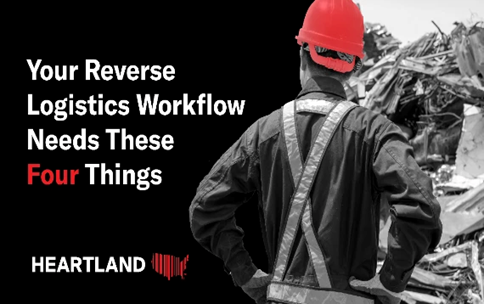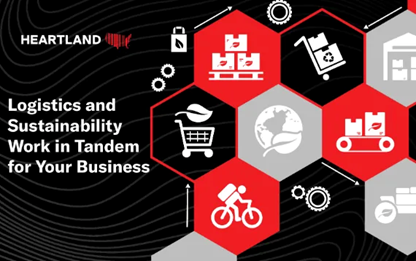
It’s Time to Revisit Your Reverse Logistics System. Here’s Why
Nov 16, 2023
Every day, thousands of orders stream through warehouses and distribution centers across the globe. The expectation is that once a transaction is complete, products will find a home with their end users. However, that is not always the case. About 20-30% of orders are later returned to the seller due to factors such as the ones below:
- The product was damaged upon arrival.
- The product was incorrectly shipped.
- The product did not meet the customer’s expectations.
- The customer found the product elsewhere for a lower price.
When products are shipped back to the warehouse, they most likely enter a reverse logistics system to assess quality and prepare for reselling or disposal. Today’s dynamic supply chain is marked by growing competition among brands, changing consumer expectations, and updated quality regulations – all contributing to more product returns and placing greater pressure on reverse logistics systems. Moreover, past studies show that return rates further elevate following peak seasons. Just a few years back, 10.6% of holiday purchases were returned – the equivalent of $428 billion. As a new year approaches, supply chains are encouraged to evaluate and optimize their reverse logistics systems to stay ahead of return spikes and competing brands.
Strengthening the Basics of Reverse Logistics Management
Companies that have effective reverse logistics systems in place can reduce costs, improve customer satisfaction, and even generate new revenue streams by reselling returned products. Proper recycling and disposal are also crucial for products that can’t be resold. To smoothen workflows, specialists recommend optimizing the basic pillars of successful returns management.
- Customer Service
The process of returning a product can be frustrating and time-consuming for customers, which is why one in three customers will avoid a brand after a negative experience. A clear and transparent return policy will help customers feel more confident about their purchases and more likely to do business with the company again.
Providing quality customer service hinges on your team’s connection to data. As customers reach out for assistance, your team may need access to updated shipping ETAs and stock availability. As a result, businesses seeking to improve reverse logistics are often encouraged to strengthen connectivity to empower teams with relevant data at any point of the return.
- Transportation Management
Transportation management has proven essential since returned items must be tracked separately from brand-new products. By using a digitized management process, companies can track stock as it’s transported from the customer to the warehouse or refurbishment facility. This process should manage information such as shipment dates and delivery times to help identify potential bottlenecks or delays.
Once again, automation plays a vital role in tracking transported goods during shipping. Bluetooth-enabled indicators and trackers are one of the many novel technologies improving traceability in reverse logistics since they notify businesses of a product’s whereabouts and the estimated time of delivery.
- Quality Control
When products are returned, they must be inspected and assessed for quality before they can be resold or recycled. An effective quality control process can help identify the cause of the return and prevent similar issues from occurring in the future.
To achieve efficient quality control, companies must have an established process for inspecting and testing returned products. This process should include a checklist of potential issues, such as damage, missing parts, or defects, and a system for tracking the results of the inspection. Companies may also use barcode scanning or RFID tagging to streamline report sharing and reduce errors.
- Relabeling for Reselling
After passing through quality control, products are now ready to be resold. Digital inventory management reports will need to be updated to reflect incoming stock-keeping units (SKUs) while signaling differences between brand-new and returned items. Products may then be placed back on the shelf following company guidelines.
While several tools can help prepare returned items for resale, a notable mention should go to your label printing system. Workers can print updated labels and price tags from anywhere in your facility to prepare inventory for future movement down the supply chain.
- Recycling and Disposal
Not all returned products can be resold or refurbished. Some products may be damaged beyond repair, obsolete, or otherwise unsuitable for resale. In these cases, companies must have a plan for recycling or disposing of the products in an environmentally-friendly way.
Efficient recycling and disposal involve a comprehensive understanding of local and national regulations. Therefore, it’s encouraged that companies develop a standard process for identifying and separating recyclable materials from non-recyclable waste. This can also support other sustainable initiatives in your business.
Related: Explore the close relationship between sustainability and logistics.
How to Start Optimizing Your Reverse Logistics System
As with most automation solutions, optimization is simpler when working with an efficient strategist. Our in-house team of specialized technicians partners with you to:
- Survey your current reverse logistics management system - The first step to optimizing workflows is to understand your current system. Document and analyze the entire process from the moment a product is returned to the moment it is resold or disposed of to identify any bottlenecks, blind spots, or unnecessary labor.
- Establish measurable key performance indicators - Once you have a better understanding of your current system, your solution provider should help you outline clear goals for what you want to achieve through optimization. Common goals include reducing return rates, minimizing shipping ETAs, and minimizing stagnant stock.
- Gather inventory data onto a digital platform – Adjust connectivity infrastructures to maximize visibility into incoming return requests, monitor changes in stock quantities, and empower better customer service.
- Deploy a transportation management solution - Transportation management is essential since returned items must be tracked separately from brand-new products. From automated data capture to RFID tracking, your solution provider should help you procure and deploy hardware and software that delivers in-motion visibility for shipped products. Tracking data can also be matched to preset quality paraments to ensure stock meets compliance and quality standards.
- Digitize inventory management – By combining barcode scanning and computing, businesses can digitize inventory management to streamline the relabeling process for reselling returned items. Newly tagged products are simply scanned to update stock counts instead of relying on manual data capture.
- Establish a recycling and/or disposal plan – Lastly, empower your sustainability efforts with a reverse logistics solution that proactively disposes of ineligible products. Updated storage plans can help segment inventory to keep disposed items secluded from profitable stock.
Have More Reverse Logistics Questions?
While the discussed tips are helpful to get started, we understand individual businesses may need closer assistance to pinpoint growth areas and implement new systems. Meet up with our automation team for more personalized optimization recommendations and stay ahead of challenging returns with a team at your side.




